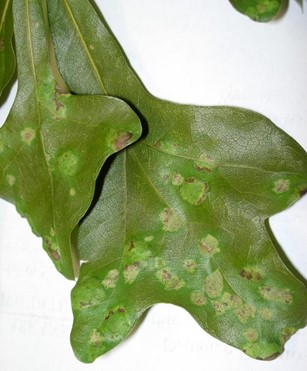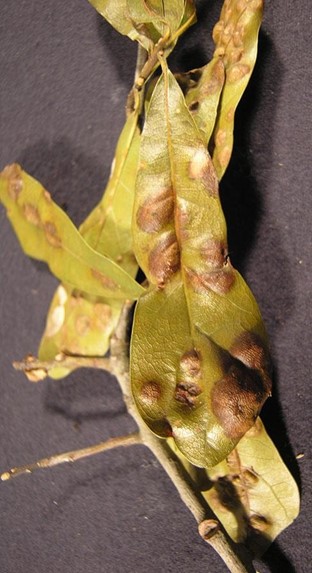Disease Notes
Contact
Plant Diagnostician
Phone: (479) 575-2727
Email: ssmith@uada.edu
Jason Pavel
Diagnostician
Phone: (479) 575-7257
Email: jpavel@uada.edu
University of Arkansas System Division of Agriculture
Cralley Warren Building
Room 16
2601 N. Young Ave.
Fayetteville, AR 72704
Oak Leaf Blister
by Sherrie Smith and Jason Pavel

Oak Leaf Blister – Taphrina caerulescens
Photo by Sherrie Smith University of Arkansas Cooperative Extension
A common fungal leaf disease of oak is Oak Leaf Blister, caused by Taphrina caerulescens. All oak species are vulnerable with red oaks being particularly susceptible. Prolonged periods of cool, wet weather in the spring are conducive to disease development.
What are the signs of Oak Leaf Blister?
Symptoms become apparent in early summer like yellow, blister-like circular, raised areas, 1/16 to 1/2 inch in diameter. The blisters are scattered over the upper leaf surface with corresponding gray depressions on the lower surface. As the spots age, they turn from yellow to brown with pale yellow margins, becoming dull brown. Several blisters may coalesce and cause the leaves to curl. Although unsightly, the disease usually does not greatly impact tree health.
How can you control Oak Leaf Blister?
Control consists of raking up all fallen leaves and twigs, and the application of preventative fungicides where practical. Practicality usually depends on tree size as most homeowners are unable to reach the canopy of large oaks. One application of Chlorothalonil, copper, or mancozeb during dormancy is effective. Fungicides do not have any effect after bud swell in the spring.

Oak Leaf Blister – Taphrina caerulescens
Photo by Sherrie Smith University of Arkansas Cooperative Extension
Take Aways
- Rake up all fallen leaves.
- Chlorothalonil, copper, or mancozeb is effective.
- Apply fungicides during dormancy.
This work is supported by the Crop Protection and Pest Management Program [grant no. 2017-70006- 27279/project accession no. 1013890] from the USDA National Institute of Food and Agriculture.